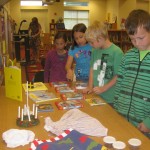Sweden
The author of Pippi Longstocking was from Sweden. Her name is Astrid Lindgren. Sweden is also home to Swedish fish. Sweden has lots of famous people.
Lots of cars were made in Sweden like the Volvo. Sweden’s favorite sport is hockey because it is more up north where there is colder weather.
Sweden’s favorite food is fish and it is a tradition to eat crayfish in the midsummer. Some of the other foods are Swedish meatballs and pea soup.
In one of the holidays the oldest girl in the house wakes up early and wears a special white dress and goes to the church with a candle to light the way and sings a song.
Carson M. – 2nd grade
Sweden
They have a King and Queen. The Queens travels a lot. Every midsummer they build a huge cross and put flowers on it and dance around it. December 13th the oldest child wakes up early and wakes up the parents. It has to be a blond hair girl that has a candle on her head because it’s the darkest night. They eat pea soup with pancakes. They have lobsters. They crack the head open and eat it. They also have boarding school where Mrs. Broms-Their went to stay. A lady author wrote Pippi Longstocking. She is the strongest girl and she has adventures. She has no parents. Emil is a naughty boy that she wrote about. They made movies about both of them.
Angelina R.

– 2nd grade














